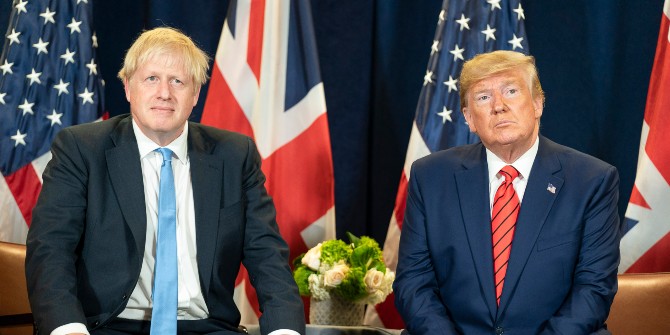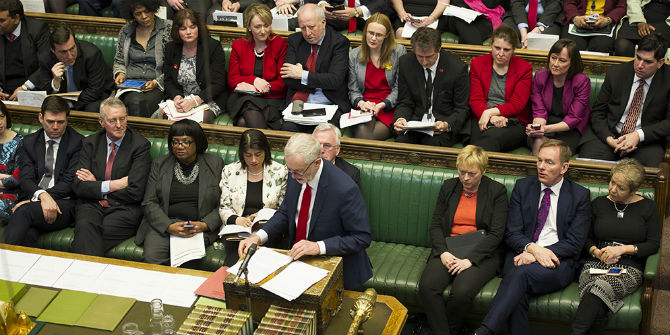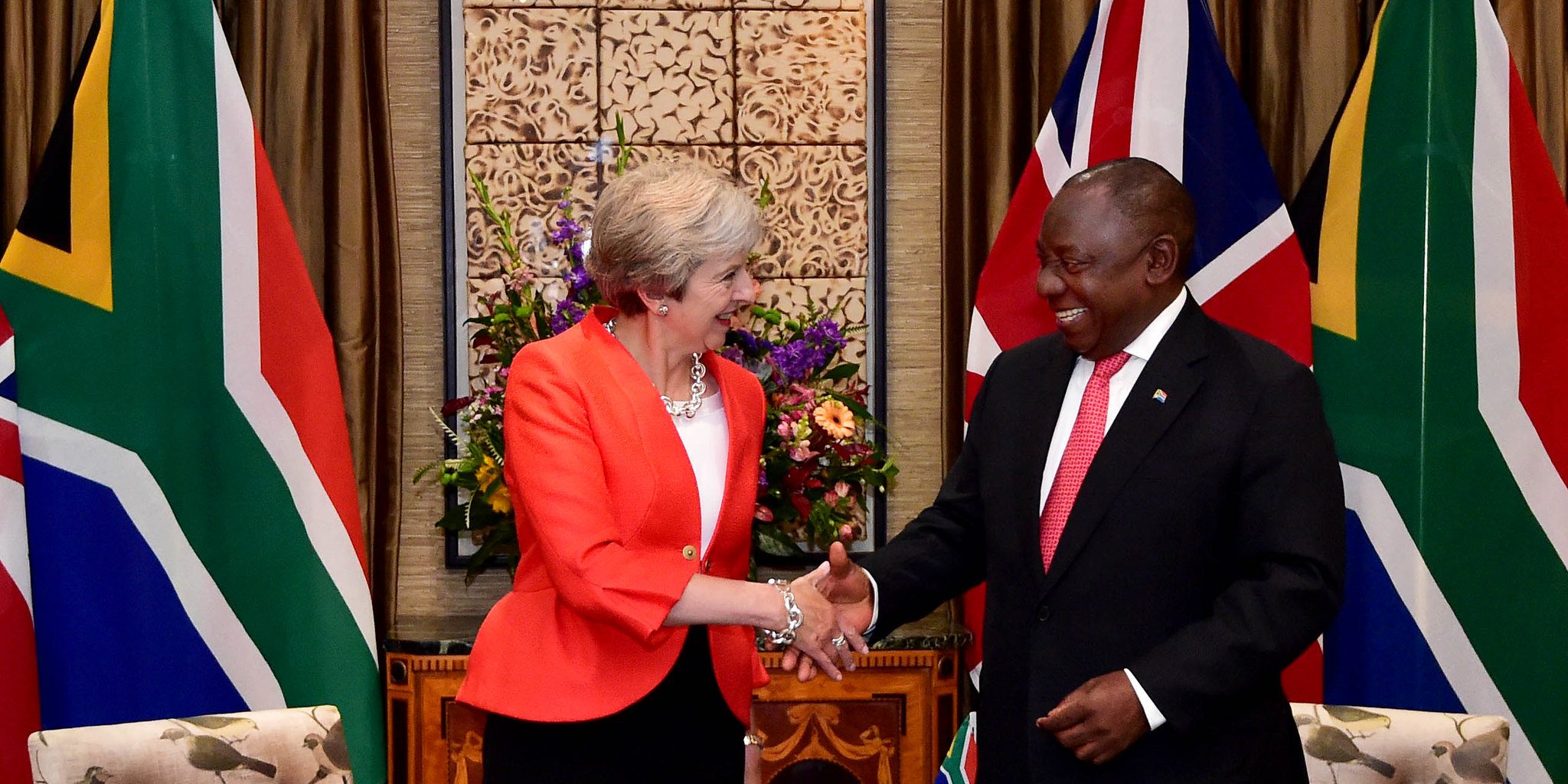In late June, trade and LSE experts met over Zoom to talk about the future of the North Atlantic Trade Triangle. Elitsa Garnizova (LSE) reports on the discussion.
The United States and the European Union are the two most integrated trading blocs in the world. They have increased their economic interdependence with linkages in global supply chains, ecommerce and investment. The trade flows between the two partners account for a third of world trade flows, totalling more than £1 trillion in 2019, and the two account for more than half of global foreign direct investment.

The transatlantic relationship has been confronted by the new domestic politics of international trade and the specific challenges of Brexit, the trade policy stance of the US administration, and the role of China in the global economy. The UK forms a large share of US trade and investment with Europe, and Brexit makes the North Atlantic Trade Triangle between the three partners very important for global trade.
In a hearing before the House of Representatives in June, US Trade Representative Robert E Lighthizer accused the European Union of “thinly veiled protectionism” for lack of access of American agricultural products to the EU market. He also declared that a deal between the EU and US is “not looking good in the short term”. Threats of more tariffs from the US side are on the table, at a time when EU businesses are trying to recover from COVID-19 and any additional costs may further impede recovery.
Against this backdrop, the UK and the US have formally launched trade negotiations, while “serious divergences remain” in the negotiations between the UK and the EU.
The US approach to trade: Trump 2.0 or Biden?
The current approach of the US administration to trade policy has been described as transactional and grounded in ad hoc deal-making with a strong belief in bilateral over multilateral negotiations. As Lighthizer’s testimony stated “the President will use tariffs if he has to to get a fair share for American businesses.” The US administration’s current motto “tariffs work great” contradicts a range of economic and policy assessments. Fed economists Aaron Flaaen and Justin Pierce found that “tariff increases enacted in 2018 are associated with relative reductions in manufacturing employment and relative increases in producer prices”. The study also highlighted that the small positive effect tariffs have on reducing competition via import protection are offset by the negative effect via increased input costs and retaliatory tariffs.
Not only that, but the administration has spiralled into what economists call “cascading protection”, where it needs to impose new tariffs to help industries suffering because of previous tariffs. In turn this causes significant uncertainty for both US and EU businesses. Only in the past month, the administration has initiated consultations on additional tariffs on wines, cheeses, olives, coffees and biscuits as part of the Boeing case, and has threatened Section 301 investigations into countries adopting digital services taxes, after withdrawing from international talks. Lurking in the background is the threat of car tariffs, which were initially raised in 2019.
The EU does not have too many obvious moves – it can negotiate and be perceived as negotiating under threat (European Parliament resolution) or refuse to negotiate and risk major impact on key industries, including its car sector (Ifo study). Those who recall the challenges surrounding Transatlantic Trade and Investment Partnership (TTIP) will remember that any new negotiations will be very challenging, due to consumer and environmental campaigners’ grievances with the US. It is one of those situations where a win is hard to define.
A second Trump administration is expected to be more of the same or worse, with continued antagonism towards Europe and little sign of cooperation. One area where cooperation is emerging, despite being long overdue, is the dialogue on China: currently few details exist, but the goal of the forum would be to tackle issues such as Chinese disinformation, with trade remaining a less likely topic of discussions. The US administration is also disengaging from the World Trade Organisation (WTO).
In contrast to Trump, Joe Biden, the Democratic presidential nomination, is an internationalist, who is keen to work within the multilateral rules-based system and work to strengthen it. He would probably abandon recourse to the Section 232 national security exception, rebuilding alliances and restoring credibility. However, Biden is not fully persuaded on the economic benefits of trade versus the strategic ones and he will have to win over blue-collar voters in battleground states.
Tension between the US and the EU will persist regardless of the administration, particularly on security (burden-sharing), trade (agriculture and future of world trade such as digital trade, green economy, healthcare product and services), and China (from disinformation to trade). From a business perspective tariffs, public procurement and standards are perceived as thorny subjects. There is a need for the EU to prepare, once Biden is in place, to engage with clear priorities and offerings.
Most importantly, some of the changes we have seen over trade policy are not only down to the current administration. There has been a tremendous reversal of Republicans and Democrats positions vis-à-vis trade policy. The politics of trade among policy makers is not as clear-cut as before. While a majority of US citizens say that trade is a good thing, long term changes have ambiguous effects on trade policy: ageing populations and younger voters’ preference for Democratic candidates will have uncertain effects.
The EU’s trade priorities and engagement with the US
One of the main goals for the EU has been to keep the dialogue with the US alive while pursuing other bilateral agreements and sustaining commitment over multilateral fora. After the suspension of the Transatlantic Trade and Investment Partnership, talks with the US were restarted in 2017 between Cecilia Malmström, then EU’s trade commissioner, and Wilbur Ross, the Trump administration’s commerce secretary. Three years later, there is a very low level of ambition, mostly in terms of low-level liberalisation of agricultural trade or imports of American oysters and other shellfish to the EU in return for European sales of apples and pears in the US. The EU is engaging with the US on the trilateral dialogue with Japan on industrial subsidies, on taking China to WTO court and on specific instances of regulatory cooperation.
The key question for the European Union is whether it is ready to act more strategically – for example, by using existing resources in a more intelligent way. The European Commission has coined the term “open strategic autonomy” to signify its goal to address the resilience of international supply chain.
Recent discourse from the Commission highlights a shift away from its preference for projecting soft power towards stronger focus on defending the EU’s interests. In the words of Josep Borell at the European Council on Foreign Relations:
Strategic autonomy is a way of framing our choices: we must be able to defend our interests, by ourselves if necessary. We should look at the world through our own prism and avoid both nostalgia and fatalism.
The new phraseology highlights the recognition that the EU should be more strategic in addressing distortive state interventions, export restrictions, and foreign investment. Given that trade is the only area of foreign policy making where the European Commission can lead the way and can rely on qualified majority voting, this is a natural place to start. There is a wider recognition that China relies on what Joseph S Nye sees as “sharp power” grounded in “subversion, bullying and pressure, which combine to promote self-censorship” versus the attraction and persuasion of “soft power” or military “hard power”. While in 2019 the Commission and the European External Action Service took a large leap and declared China a “systemic rival”, the EU is still divided on how to be tougher in strategic investment, human rights, and values. How far it is willing to go for an agreement, and what it would be offering?
The UK’s position in the North Atlantic Trade Triangle
How do these developments affect the UK’s external economic position? For context, in 2019 the EU accounted for 47% of the UK’s total trade (43% of exports and 49% imports) while the US accounted for a fifth of UK exports and 13% of imports.
One of the stumbling blocks to being a critical friend in the North Atlantic Triangle is the UK’s ideological desire to break free from the EU, regardless of the price that it has to pay and whether this is the best way forward. The UK has not clarified what its priorities in trade negotiations are. We had a preview of what is bound to happen in early July, when the National Farmers Union gathered more than 1,038,900 signatures for a petition to maintain the UK’s high food standards. The US has signalled readiness to work with the UK on a swift agreement, but US business are waiting to see the outcome of the EU-UK negotiations. The US administration is also keen to ensure full access for US agricultural products.
On the other hand, FTAs are not the only game in town; some of the UK’s priorities can be achieved outside them. Moreover, trade strategy should be considered in light of the broader national economic and foreign policy objectives, with the clear understanding that the UK will need to prioritise across different objectives and tools. The decisions the UK makes about things like domestic regulation, geographic indications, and the precautionary approach will have an impact on the trade agreements it can make with the EU and the US.
One of the UK’s ambitions post-Brexit is to “advance trade for the modern era”, focusing on services, environment and digital, with an emphasis on the UK’s desire for leadership. This signals possible areas of cooperation in the North Atlantic Triangle, where the UK can possibly identify opportunities such as ecommerce and progress discussions on the green and circular economy. While divergence remains on internet taxes and data privacy, there is a possibility for a low-ambition agreement, particularly in the absence of a wider WTO agreement.
However, a lot of internal obstacles persist. Both the discarded Chequers plan and Boris Johnson’s win in the ‘red wall’ highlight that the UK government will have to deliver for both manufacturing and services, as well as producers and consumers, across the regions of the UK. The COVID-19 pandemic has made the climate even more difficult. As Swati Dhingra and Josh De Lyon highlighted in a recent blogpost, businesses paint a bleak picture for the recovery in economic activity and jobs.
Research shows that even if the UK pursues a policy of seeking new trade agreements, the UK will incur substantial losses from increased trade barriers with the EU. Therefore, agreement with its largest trade and investment partner is absolutely crucial.
What’s next for the North Atlantic Trade Triangle?
While another TTIP-style agreement might not be on the table, there is scope for smaller negotiations to take place to sustain the dialogue between the EU and the US and avoid further escalation.
The UK will have to be pragmatic towards both the EU and the US and put ideology aside. The United States-Mexico-Canada Agreement (USMCA) negotiations provide a good example for the UK negotiators: it is likely that the UK will have to follow the US template in multiple chapters and part of the success will be the optics of the negotiations, i.e. making sure that it is a win for any US administration.
This post represents the views of the author and not those of the Brexit blog, nor LSE. A longer version of this write-up is available here.







Once Brexit is achieved interest for that triangle will wane. Why divert goods and services in the long term through the UK in order to serve either US. or EU when you’re in one of those economies?
Short term, there’s an evident interest but long term?
UK will be seen by the two blocs as a very important satellite but as only as a satellite. It won’t be an entry point to the EU. How could you invest there to access an other market when EU UK US relations are not known? Be it in 2020, 2025 or 2040.simpler to just invest in EU US relations, less unknowns.
n contrast to Trump, Joe Biden, the Democratic presidential nomination, is an internationalist, who is keen to work within the multilateral rules-based system and work to strengthen it. He would probably abandon recourse to the Section 232 national security exception, rebuilding alliances and restoring credibility. However, Biden is not fully persuaded on the economic benefits of trade versus the strategic ones and he will have to win over blue-collar voters in battleground states.